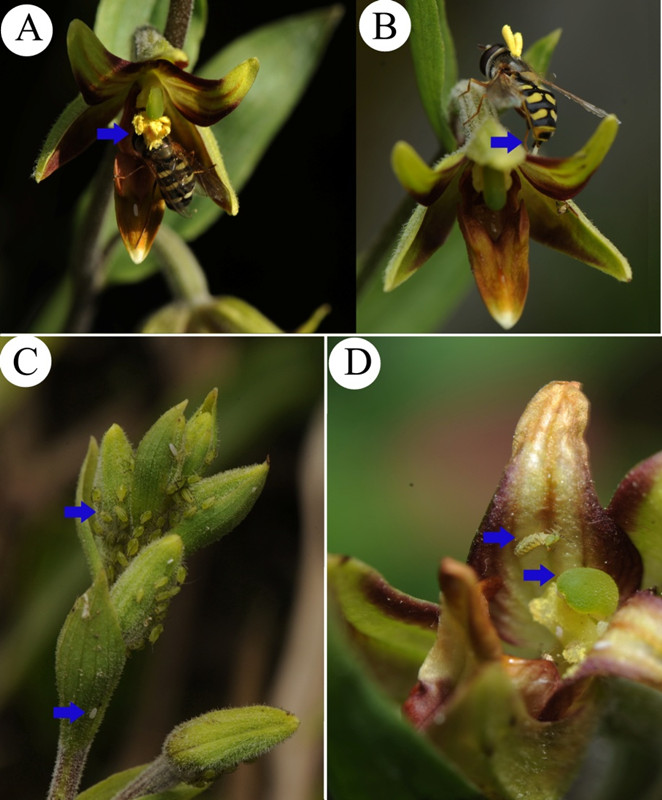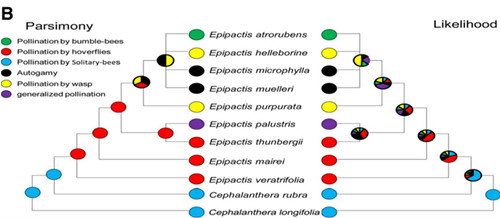中科院揭晓兰科植物欺骗性传粉的起源之谜

在花上的食蚜蝇

火烧兰属传粉系统的进化式样
兰科植物欺骗性传粉的起源长期以来是困扰进化生物学家的难题之一。产卵地拟态是一类兰花利用雌性昆虫的产卵行为,在形态和气味上拟态昆虫的产卵地,从视觉、嗅觉和触觉等方面吸引昆虫产卵,从而实现传粉的拟态方式。对疏花火烧兰(Epipacits veratrifolia)分布在地中海的居群研究认为,该兰花拟态蚜虫气味,吸引取食蚜虫的雌性食蚜蝇到花上产卵并传粉,这是一种拟态蚜虫感染的产卵地拟态模式。然而,在这种拟态系统中,兰花的拟态模型是蚜虫感染其它同域分布的植物,还是拟态蚜虫对兰花自身的感染机制尚不清楚。
中国科学院植物研究所金效华博士等与中国科学院昆明植物研究所任宗昕博士、王红研究员等合作,对沿怒江分布的疏花火烧兰10个居群,开展了传粉生态学和化学生态学研究综合,并利用DNA条形码(rbcL, matK和ITS)构建了20种火烧兰属(Epipactis)植物的系统发育树,探讨了传粉系统的演化关系。
研究表明,疏花火烧兰在蕾期和初花期,被茄沟无网蚜(Aulacorthum solani)感染,访花的雌性大灰食蚜蝇(Eupeodes corollae)和黑带食蚜蝇(Episyrphus baleatus)在植株和花蕾上产卵,卵发育成幼虫后以蚜虫为食。该兰花进入盛花期后,散发的花气味成分具有与蚜虫体表挥发物相似的化合物,同时,绿色药帽在形态上拟态蚜虫,继续吸引食蚜蝇到花上产卵和传粉。
该传粉系统是一个从有报酬的互利合作,向产卵地拟态的欺骗性转变的过渡系统;产卵地拟态可能是火烧兰属的祖先类型;拟态蚜虫的产卵地拟态可能起源于有报酬或者部分有报酬的传粉系统,这一研究新发现,对深入理解欺骗性传粉系统的起源和演化具有重要意义。
研究成果近日发表在国际刊物BMC Plant biology上。研究得到了国家自然基金(31107176)、国家重大科学研究计划项目(2014CB954100)和中国科学院重点部署项目(KJZD-EW-L07)的支持。
原文摘要:
Xiao-Hua Jin, Zong-Xin Ren, Song-Zhi Xu, Hong Wang, De-Zhu Li andZheng-Yu Li
Background
It is estimated that floral deception has evolved in at least 7500 species of angiosperms, of which two thirds are orchids. Epipactis veratrifolia (Orchidaceae) is a model system of aphid mimicry as aphidophagous hoverflies lay eggs on false brood sites on their flowers. To understand the evolutionary ecology of floral deception, we investigated the pollination biology of E. veratrifolia across 10 populations in the Eastern Himalayas. We reconstructed the phylogeny of Epipactis and mapped the known pollination systems of previously studied species onto the tree.
Results
Some inflorescences of E. veratrifolia were so infested with aphids while they were still in bud that the some larvae of hoverflies developed to the third instar while flower buds opened. This indicated that adult female hoverflies were partly rewarded for oviposition. Although flowers failed to secrete nectar, they mimicked both alarm pheromones and aphid coloring of to attract female hoverflies as their exclusive pollinators. Phylogenetic mapping indicate that pollination by aphidophagous hoverflies is likely an ancestral condition in the genus Epipactis. We suggest that the biological interaction of aphid (prey), orchid (primary producer) and hoverfly (predator) may represent an intermediate stage between mutualism and deception in the evolution of pollination-by-deceit in E. veratrifolia.
Conclusions
Our analyses indicate that this intermediate stage may be used as a model system to interpret the origin of oviposition (brood site) mimicry in Epipactis. We propose the hypothesis that some deceptive pollination systems evolved directly from earlier (partly) mutualistic systems that maintained the fidelity of the original pollinator(s) even though rewards (nectar/ brood site) were lost.
标签: 兰科植物欺骗性传粉 产卵地拟态 拟态蚜虫
作者:中科院

